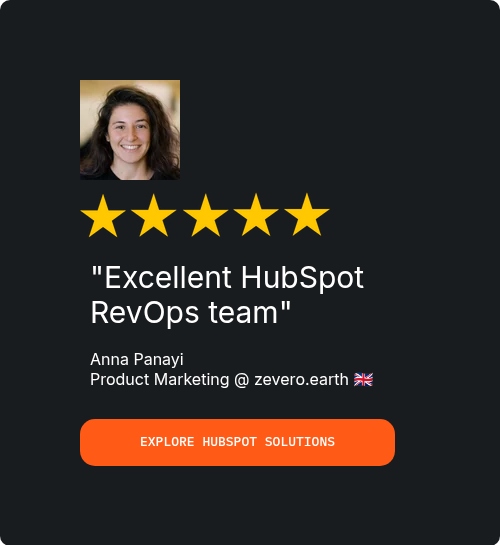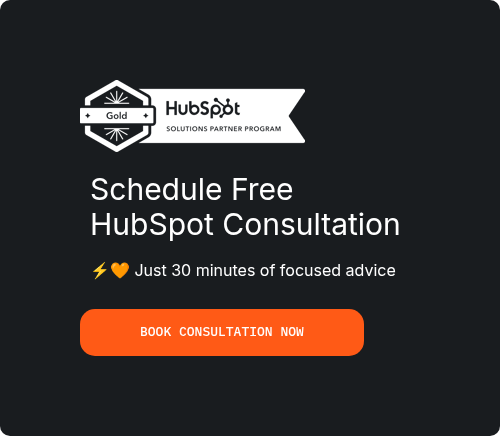
Choosing the right platform for marketing automation and customer relationship management (CRM) is a vital decision for any business, especially as we move into 2025. With increasing demands for streamlined processes, personalisation, and customer-centric strategies, having the right tool can significantly impact your business's efficiency and growth. Two platforms that often top the list in this space are Klaviyo and HubSpot.
Both Klaviyo and HubSpot bring distinct strengths to the table, excelling in different areas. The challenge lies in identifying which platform aligns best with your business goals, industry, and budget. In this blog, I’ll unpack the Klaviyo vs HubSpot comparison, focusing on their features, pricing, scalability, and suitability for businesses of varying sizes and industries. Whether you’re a growing eCommerce brand or a business seeking an all-in-one CRM solution, this breakdown will guide you towards making an informed decision.
Overview of Klaviyo and HubSpot
What is Klaviyo?
When it comes to eCommerce-focused marketing automation, Klaviyo is a name that frequently comes up. It’s designed specifically with direct-to-consumer brands in mind, offering tools for highly personalised email marketing and segmentation. If you’re an online retailer using platforms like Shopify, BigCommerce, or Magento, Klaviyo integrates seamlessly to provide a streamlined approach to customer engagement.
Its strength lies in helping businesses leverage data to create tailored customer experiences. Whether it’s tracking purchase behaviour or delivering predictive analytics, Klaviyo puts the power of personalisation into the hands of marketers. For eCommerce brands, this level of insight is invaluable in building loyalty and driving revenue.
However, Klaviyo’s focus is narrow. While it excels in email marketing and SMS capabilities, it doesn’t stretch into the wider CRM space. For businesses outside of eCommerce or those looking for a more comprehensive solution that includes sales pipelines, customer service tools, and broader marketing automation, Klaviyo’s limitations start to show.
If you’re a DTC brand with a heavy reliance on email marketing, Klaviyo might just be the specialised solution you need. But for those seeking an all-in-one platform, it’s worth considering how tools like HubSpot compare.
What is HubSpot?
HubSpot stands out as a powerhouse in the CRM space, offering a comprehensive platform that goes beyond just marketing automation. As someone deeply invested in helping businesses unlock the full potential of HubSpot, I can confidently say it’s more than just a tool – it’s a strategy enabler.
Designed to cater to businesses of all sizes and across various industries, HubSpot brings marketing, sales, and customer service into one cohesive system. Whether you’re a small business building your first sales pipeline or an enterprise scaling global marketing campaigns, HubSpot’s flexibility and scalability provide the tools you need to grow.
One of HubSpot’s greatest strengths is its intuitive interface, which allows users to quickly adopt the platform and start seeing results. From creating seamless workflows to managing complex reporting, it simplifies what could otherwise be overwhelming processes. For businesses seeking not just a CRM but a partner in growth, HubSpot is a standout choice.
What sets HubSpot apart is its ability to scale with your business. As you grow, you’re not locked into a static platform; instead, you gain access to features that support advanced automation, deeper analytics, and more personalised customer experiences. It’s this scalability and ease of use that have made HubSpot a favourite for businesses looking for a CRM that evolves alongside them.
If you’re considering a CRM to centralise your operations and fuel your growth, HubSpot isn’t just an option – it’s a game-changer.
Key Features Comparison – HubSpot vs Klaviyo
Marketing Automation
Klaviyo shines in the eCommerce space with its advanced email marketing capabilities. Dynamic segmentation, predictive analytics, and A/B testing are at the core of its offering. These tools make it a go-to for businesses aiming to create highly personalised campaigns that align with customer behaviours. For brands looking to deliver hyper-targeted emails and SMS campaigns, Klaviyo provides a robust platform.
HubSpot, on the other hand, takes a broader approach. Its multi-channel marketing capabilities span email, social media, and ads, making it ideal for businesses with diverse customer touchpoints. As a HubSpot partner consultancy, I’ve seen first-hand how its sophisticated workflows empower businesses to automate their entire marketing funnel. From nurturing leads to driving conversions, HubSpot enables brands to craft seamless experiences across every stage of the customer journey.
Choosing between these platforms depends largely on your business type. For eCommerce businesses looking for a platform tailored to their industry, Klaviyo is a strong contender. However, if you’re seeking a versatile tool that can support marketing across channels while integrating with your sales and service operations, HubSpot’s comprehensive suite is unparalleled.
Integration Options
Integrations are at the heart of how modern businesses operate, and this is where Klaviyo and HubSpot diverge significantly.
Klaviyo has carved out its niche by focusing on eCommerce businesses. Its seamless integration with platforms like Shopify, WooCommerce, and Stripe makes it a go-to choice for brands that rely heavily on online sales. These integrations allow businesses to sync customer purchase data effortlessly, personalise email campaigns based on shopping behaviour, and even optimise abandoned cart flows. For businesses rooted in the eCommerce ecosystem, Klaviyo offers an impressive toolkit.
HubSpot, on the other hand, provides a far broader integration network, catering to industries beyond eCommerce. With compatibility with tools like Slack for team collaboration, Salesforce for advanced CRM needs, and Google Workspace for everyday operations, HubSpot shines as a centralised hub for businesses aiming to unify their processes. Its strength lies in helping organisations of all sizes and sectors streamline workflows while enabling marketing, sales, and service teams to work in harmony.
From my experience working with HubSpot implementations, I’ve seen its integrations go beyond just connecting apps—they enable businesses to craft truly cohesive strategies. If your priority is deep eCommerce functionality, Klaviyo is hard to beat. But if you're looking for an all-encompassing platform that scales across industries, HubSpot stands head and shoulders above. The right choice really depends on your operational focus and long-term growth ambitions.
Reporting and Analytics
Analytics are the backbone of any successful strategy, and both Klaviyo and HubSpot shine in their own right here—but in very different ways.
Klaviyo is built for precision in the eCommerce space. It delivers deep insights into email performance, customer segmentation, and revenue attribution, allowing businesses to track exactly how their campaigns translate into sales. The platform’s predictive analytics give marketers the edge by forecasting customer behaviour, which is invaluable for personalisation at scale. For brands selling directly to consumers, Klaviyo’s analytics help turn data into a competitive advantage.
On the other hand, HubSpot steps in with a much broader toolkit for reporting. It caters to businesses that need visibility across marketing, sales, and service teams. HubSpot’s dashboards don’t just show metrics—they tell a story. You can track everything from campaign ROI to customer journey bottlenecks and even create bespoke reports that reflect your business priorities. For example, a client I worked with recently used HubSpot’s advanced analytics to identify inefficiencies in their sales process, which helped them improve their pipeline velocity by 25%.
The choice here is not about which platform is better but about what you value most. If your focus is on email and SMS campaigns for eCommerce, Klaviyo is the perfect match. However, if you need a platform that delivers a big-picture view of your entire customer lifecycle, HubSpot is the clear winner. As a HubSpot partner, I’ve seen first-hand how its reporting capabilities can empower teams to make data-driven decisions that fuel growth.
User Experience and Interface
Klaviyo offers a streamlined interface tailored specifically for marketers, particularly those in eCommerce. Its design prioritises ease of use for crafting email and SMS campaigns, with straightforward navigation that allows users to quickly set up workflows and analyse campaign performance. However, for businesses looking to expand beyond email marketing into broader CRM functionalities, Klaviyo's simplicity may start to feel limiting. Its focus is clear and effective, but it’s not designed to handle multi-departmental needs.
On the other hand, HubSpot excels in creating a seamless experience for teams across marketing, sales, and customer service. Its intuitive design makes it easy to onboard new users, while its customisable dashboards allow businesses to tailor their view to what matters most. Whether you’re a marketer analysing campaign performance or a sales team tracking deal pipelines, HubSpot ensures everyone is on the same page. From my experience as a HubSpot partner, I’ve seen businesses significantly improve internal collaboration simply by leveraging HubSpot’s user-friendly and scalable interface.
When choosing between the two, consider your team’s requirements. If you’re an eCommerce business needing a tool focused on campaign creation, Klaviyo is a solid choice. However, for businesses that need a system that caters to multiple departments and supports cross-functional collaboration, HubSpot provides the comprehensive solution.
Pricing Comparison: Klaviyo vs HubSpot
Klaviyo Pricing
- Free Plan: Ideal for small eCommerce businesses, this plan supports up to 250 contacts and 500 email sends per month.
- Paid Plans: Pricing starts at approximately £15/month and scales based on your contact list size and usage. SMS marketing is an additional cost, which gives flexibility for businesses focusing on email or SMS separately.
- Best For: Klaviyo suits cost-sensitive eCommerce businesses aiming to enhance their email and SMS marketing capabilities with scalability in mind.
HubSpot Pricing
- Free Plan: Offers essential CRM tools for unlimited users, including contact management, basic email marketing, and live chat functionality.
- Starter Plan: Begins at £15/month per user, providing access to advanced marketing tools and basic automation, making it a great starting point for small teams.
- Professional Plan: Costs £600+/month (up to 3 users), offering extensive features like workflow automation, detailed reporting, and custom pipelines
- Enterprise Plan: Starts at £3,000+/month and is designed for larger organisations needing enterprise-grade tools like custom objects, predictive lead scoring, and enhanced reporting.
- Best For: HubSpot is ideal for businesses seeking an all-in-one CRM and marketing platform that scales effortlessly across marketing, sales, and service teams.
Pricing often becomes a decisive factor, but it’s crucial to evaluate it in the context of value. Klaviyo’s pricing is transparent and flexible for eCommerce-focused businesses that want to leverage segmentation and SMS/email marketing. However, for businesses needing a holistic solution across multiple departments, HubSpot’s pricing structure, while higher, reflects the breadth of its functionality.
I’ve seen clients thrive by choosing the plan that aligns with their growth strategy. If you’re scaling across teams or require cross-functional collaboration, investing in HubSpot’s Professional or Enterprise plans can deliver exceptional ROI. On the other hand, if your business revolves around targeted campaigns and customer segmentation, Klaviyo’s cost-effective plans make it an excellent choice for eCommerce.
Ultimately, the best choice depends on whether you prioritise multi-departmental CRM functionality or a highly-focused marketing tool. Both platforms deliver value when matched to the right business model.
Pros and Cons of Klaviyo and HubSpot
Klaviyo Pros and Cons
Pros:
- Excellent for eCommerce businesses: Klaviyo is tailored for online retail, making it a top choice for businesses that rely heavily on email and SMS marketing.
- Advanced personalisation and segmentation: Its ability to create highly targeted campaigns based on customer behaviours and preferences sets it apart.
- Scalable for both email and SMS marketing: As your business grows, Klaviyo offers flexibility in scaling your outreach without compromising on quality.
Cons:
- Limited CRM functionality outside eCommerce: While exceptional for online retailers, it lacks the comprehensive CRM capabilities needed by service-based or B2B businesses.
- Costs increase rapidly as your contact list grows: Pricing is contact-based, which can quickly become expensive for businesses with larger databases.
HubSpot Pros and Cons
Pros:
- Comprehensive tools for marketing, sales, and service: HubSpot’s all-in-one approach makes it versatile for businesses looking to unify their operations on a single platform.
- Highly scalable for businesses across industries: From startups to enterprises, HubSpot’s scalability ensures that businesses can grow without outgrowing their CRM.
- Extensive training resources and support: HubSpot Academy and dedicated support channels empower users to make the most of the platform.
Cons:
- Higher upfront costs for advanced features: While the free plan is robust, unlocking HubSpot’s full potential requires a significant investment.
- May feel overwhelming for small, niche-focused businesses: For teams with narrow requirements, HubSpot’s breadth of features can seem excessive or unnecessary.
When evaluating Klaviyo vs HubSpot, the decision hinges on your business model and growth trajectory. Klaviyo excels in eCommerce scenarios where personalisation and segmentation are critical. However, if your business spans marketing, sales, and service—or operates in industries beyond eCommerce—HubSpot’s breadth and depth make it the stronger contender.
From my experience as a HubSpot partner, businesses often underestimate the value of having a unified CRM until they face scalability challenges. While Klaviyo’s simplicity and eCommerce focus are admirable, HubSpot’s versatility equips businesses to handle complex workflows and cross-functional operations seamlessly.
It’s not about choosing the “better” tool but identifying the one that aligns best with your objectives. Both platforms can deliver remarkable results if leveraged strategically.
Choosing the Right Tool for Your Business
When to Choose Klaviyo
Klaviyo stands out as the go-to option for eCommerce and direct-to-consumer (DTC) brands prioritising email and SMS marketing. Its seamless integration with platforms like Shopify and BigCommerce, coupled with its powerful segmentation tools, makes it a natural choice for businesses aiming to deliver hyper-personalised campaigns. If your primary focus is optimising customer retention and driving repeat purchases through targeted communication, Klaviyo is hard to beat.
When to Choose HubSpot
HubSpot, on the other hand, is ideal for businesses looking for a holistic, centralised CRM solution. Its comprehensive tools for marketing, sales, and customer service enable teams to collaborate effectively across departments. Whether you’re scaling operations, managing a diverse customer base, or requiring robust analytics, HubSpot’s versatility equips your business to thrive. It’s particularly well-suited for businesses that value a streamlined workflow and a unified customer experience.
Factors to Consider
-
Business Size and Industry:
Klaviyo is tailored for online retailers, offering deep value to eCommerce stores. Meanwhile, HubSpot’s flexibility accommodates a broader range of industries, from professional services to SaaS and beyond. -
Budget:
Klaviyo’s pricing is transparent and scales with contact list size, which works well for smaller operations but can become expensive as your business grows. HubSpot’s free CRM plan offers an excellent starting point for small businesses, with more features unlocked at higher tiers, providing room to scale intelligently. -
Growth Projections:
If your business is scaling rapidly or plans to expand into multiple channels, HubSpot’s ability to manage larger teams and complex workflows gives it the edge. Its scalability ensures that as your business grows, your CRM grows with it.
I often encounter businesses grappling with the decision of whether to adopt a specialised tool like Klaviyo or invest in a versatile platform like HubSpot. My advice is always to assess not just the tools’ current capabilities but also their alignment with your future business strategy.
Klaviyo is brilliant for eCommerce players who rely on email and SMS campaigns for growth, but HubSpot offers a broader canvas. Its ability to unify marketing, sales, and customer service under one roof means your team works smarter, not harder. Ultimately, the decision comes down to understanding your priorities and planning for the long term.
Alternatives to Klaviyo and HubSpot
While both Klaviyo and HubSpot are leading platforms, they may not suit every business's unique requirements. Here are some alternatives worth considering:
-
Mailchimp:
A reliable starting point for small businesses focused primarily on email marketing. Its user-friendly interface and basic automation tools make it ideal for those taking their first steps in digital marketing. However, it does come with limitations in CRM and advanced analytics, which growing businesses might outgrow quickly. -
ActiveCampaign:
Known for its robust automation capabilities, ActiveCampaign is a strong contender for businesses seeking powerful workflows at a competitive price. It bridges the gap between marketing and sales automation, making it suitable for mid-sized businesses with an appetite for scalability. -
Salesforce:
The heavyweight in the CRM arena, Salesforce is designed for enterprise-level businesses with complex needs. Its extensive features and customisation capabilities make it a great choice for organisations with large teams and diverse requirements. However, its steep learning curve and higher costs may be a consideration for smaller players.
Klaviyo vs HubSpot – A Comparative Table
| Feature | Klaviyo | HubSpot |
|---|---|---|
| Marketing Tools | Advanced email and SMS tools | Multi-channel campaigns |
| CRM Capabilities | Basic eCommerce CRM | Comprehensive CRM for all needs |
| Integrations | eCommerce-focused | Industry-wide integrations |
| Pricing | Affordable for small lists | Scalable plans for growth |
| Best For | eCommerce brands | All-in-one business solutions |
Conclusion
Choosing between Klaviyo vs HubSpot ultimately depends on your business goals and priorities. Klaviyo stands out for its eCommerce-focused marketing tools, while HubSpot offers a comprehensive CRM solution that caters to a broader audience.
Before making your decision, explore free trials or demos for both platforms to determine which aligns best with your needs. Whether you’re focused on personalisation or scalability, both tools have the potential to transform your marketing and customer management strategies in 2025.




